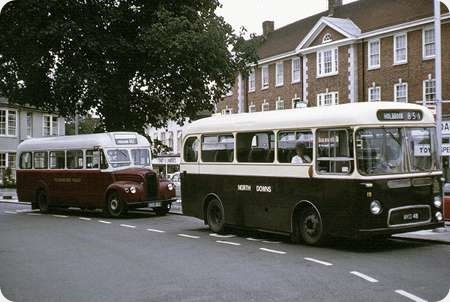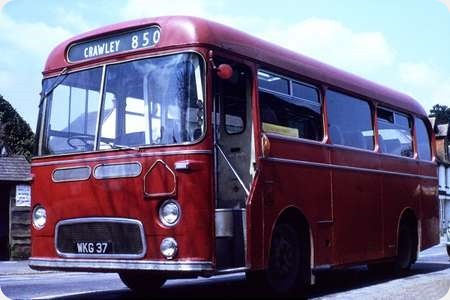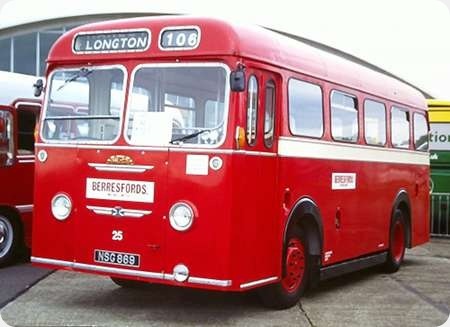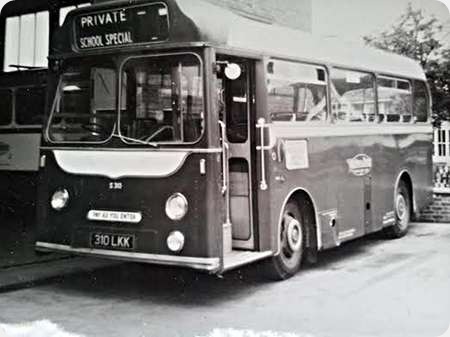

North Downs Rural Transport
1961
Albion Nimbus NS3AN
Weymann DP30F
John Wylde’s initial involvement with bus operation occurred with the Orpington Rural Transport
Association which operated a service between Biggin Hill and Orpington from 1963. Wylde departed
Association shortly afterwards and began running services as North Downs Rural Transport between
Orpington and Croydon, with journeys later serving the then new development at Forestdale, Addington. In
1969 North Downs acquired the Mitchell’s coaching business that ran rural services from Warnham into
Horsham. Then, In October 1970, A.T. Brady of Forest Green retired and his routes between Horsham,
Forest Green and Guildford were taken over by North Downs and the Brady livery of brown and cream was
adopted for ‘new’ arrivals in the fleet. To complement the assorted acquired vehicles Wylde bought a
trio of ex Western Welsh Albion Nimbus saloons, WKG 34/37/48, and numbered these 17/18/19. The first and
last received the brown livery, but WKG 37 remained in Western Welsh red to the end of operations which
occurred very suddenly on 17 April 1972. The pictures show WKG 48 in Horsham Carfax in October 1971.
Behind it , operating the Horsham - Ewhurst - Forest Green route, is Tillingbourne Guy GS MXX 382, which
had been hired in to cover mechanical problems at Forest Green, a portent of what was to come. The
unrepainted Nimbus WKG 37 is seen at Rusper on the poorly patronised meandering rural service between
Horsham and Crawley, a route that was withdrawn some months before the collapse of the business.
Photograph and Copy contributed by Roger Cox
Quick links to the - Comments Page - Contact Page - Home Page

Berresfords Motors Limited
1955
Albion Nimbus MR9
Scottish Omnibuses B32F
NSG 869 is an Albion Nimbus, with MR9 designation. This vehicle has a Scottish Omnibuses B32F body, and
in its early days was a demonstrator for the chassis builder Albion. It passed to that well-known
Staffordshire independent, Berresfords Motors Limited of Cheddleton, in whose markings we see it at
Duxford on 28 September 2003.
Photograph and Copy contributed by Pete Davies
05/05/16 - 06:58
The MR9 was the first version of the Nimbus, itself derived from the Claymore
goods model, and it was available in two lengths as the MR9N (23ft 3ins by 8ft) and MR9L (24ft by
8ft). The chassis had Albion axles, the rear being driven by overhead worm, and the wheelbase was
11ft 10ins. The four cylinder 3.83 litre EN219 engine was basically two thirds of the Leyland O350,
and it developed 60 bhp at 2200rpm. A four speed Albion gearbox was fitted. Certain features of the
design were suspect, notably the poorly designed engine by-pass valve method of providing vacuum
assistance for the braking system, and the type soon acquired a reputation for frailty, notably in
the engine, engine mountings and gearbox departments. A total of 124 of the MR9 type was produced
before Leyland in house cost cutting measures led to the appearance of the NS3 model, which had
"bought in" standard BMC 5 ton truck range axles that limited the overall width of the
vehicle to 7ft 6ins. The NS3 and later NS3AN proved to be just as unreliable as the MR9.
Roger Cox
05/05/16 - 10:57
Thank you, Roger. I have read somewhere that the amount of exhaust smoke these
things produced meant they should have been named ‘Cumulo Nimbus’.
Pete Davies
06/05/16 - 06:50
…and this from the maker who used ‘Sure as the Sunrise’ as their
slogan!
Stephen Allcroft
06/05/16 - 08:29
Delightful comment, Stephen!!!
Pete Davies
07/05/16 - 06:55
It’s strange how the heavyweight British bus manufacturers struggled to
produce a successful small bus in the post-war era. The lightweight manufacturers seemed able to
produce successful designs albeit mainly used for coach duties but the big boys never seemed to be
able to scale down the likes of the Reliance and Tiger Cub to produce what we would now call a
‘midi-bus’ with any degrees of success. Probably Bristol were the most successful with the SU
and then the LH. However I always find it difficult to judge the success or otherwise of Bristol
products based on volume of sales as throughout the 1950’s and most of the 1960’s they had a captive
market with the BTC/THC companies.
Philip Halstead
12/05/16 - 17:04
Philip.
Of course pre-war Leyland (Cub) Albion (Victor) and various
marques from Dennis Guy and Thornycroft all competed against the Bedford and came off worst, even
Ford stopped competing for a while (c1932-57). Just pre-war there were Kew Dodge and Opel Blitz
competitors, but they were selling on keen prices and immediate delivery, like Commer and Austin
post-war.
The Nimbus itself was inspired by Scottish Omnibuses building a Claymore-based 32
seat integral bus. Most of SBGs single decks were then 35-seat half cabs and all were crew operated.
This was at the same time Bristol and ECW were making the SC.
As for the SU it was only
introduced after Western and Southern National refused SC’s wanting something comparable to Devon
General’s Nimbii.
Why was the SU better than the Nimbus? I think it might have had better
engine mounting and it certainly benefitted from Bristol chassis well integrated with its ECW body.
Secondly nobody in the THC command economy would dare put an SU on a full-size route without good
reason. Finally they were confined to Western & Southern National with only a handful elsewhere and
so never got a hard life.
What we now call a midi-bus (e.g. the ADL E200) is rather bigger
than a pre-1962 Reliance or a Tiger Cub, although its seated passenger capacity may be less than an
OB.
The SC sat 35 in what were pre-1950 maximum box dimensions of 27’6" by 7’6" and
it was miraculously fuel efficient at the expense of levels of noise vibration and harshness that
would be unacceptable today providing marginal power that would be a hazard in modern dense traffic.
but again Crosville Lincolnshire and Eastern Counties mainly used them to move fresh air along empty
roads.
Stephen Allcroft
Quick links to the - Comments Page - Contact Page - Home Page

Maidstone & District Motor Services Ltd
1960
Albion Nimbus NS3N
Harrington B30F
One of Maidstone and Districts batch of Albion Nimbus/Harrington single deckers resting at the rear of
the now demolished Tonbridge Depot. Its normal duties would have been the local town service route 77
which ran a twenty minute headway. The route always had Albions which I think may have been due to
narrow roads at the town end of the route.
Tunbridge Wells also had an allocation of Albions for
town service, these periodically ventured out into the countryside on route 110 to Mayfield which
featured climbing the one in ten hill into Mayfield high street, and the route 107 out to the village of
Chiddingstone which again featured hilly terrain.
Photograph and Copy contributed by Patrick Armstrong
10/06/15 - 09:07
What many operators would have taken as a utilitarian vehicle has been turned
from a Plain Jane into a Glamour Bus by the wheel trims, the shaped destination box and M&D’s
treatment of the front under the windscreen.
A shining example of how to improve the visual
environment.
Phil Blinkhorn
11/06/15 - 10:23
I have often thought that, the frontal treatment excepted, these Harrington
bodies very closely resembled the Weymann bodies fitted to the Western Welsh and Halifax machines.
Did they share the same framing design, perhaps?
Roger Cox
25/07/15 - 06:09
Western Welsh 1-24 had Harrington bodies, the M&D batch followed on from them.
Western Welsh obviously had Weymann build 25-48 to the same outline; they also used a version of the
outline for Halifax’s infamous batch.
Stephen Allcroft
17/07/16 - 05:50
I joined the M&D in 1961 fresh out of college. Having passed my PSV test on I
think DH156 (It had a sliding window behind the driver) I set out to discover Kent and Sussex. This
was the time when we had full buses and a variety of vehicles, Leyland, AEC, Guy, Daimler, Bristol,
Commer and old SARO, RKE R4O which must have been the slowest most awkward vehicle to drive!!! Most
times I was out in rural Kent with the occasional sortie onto the main key where shift times
allowed. It was also profitable the most hours that I got paid for in one week was 108 comprising
normal shift pay plus some double and treble hours, marvellous. I still at the advanced age of 79
remember those days with nostalgia and have my original badges, drivers KK37733 and conductor
KK41873.
Reg Stubbs
Quick links to the - Comments Page - Contact Page - Home Page




